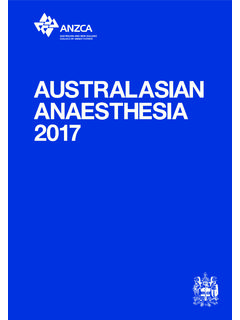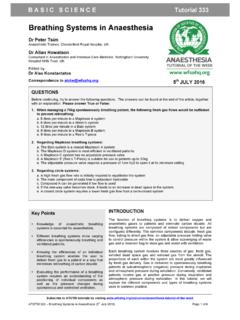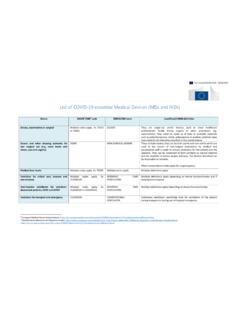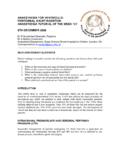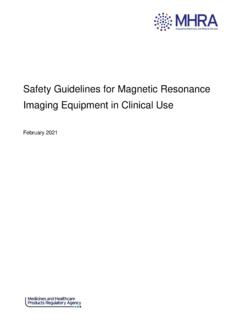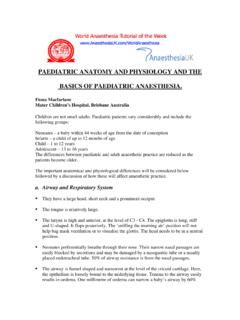Transcription of Australian and New Zealand College of Anaesthetists (ANZCA)
1 PS51. 2018. Australian and New Zealand College of Anaesthetists (ANZCA). Guidelines for the Safe Management and Use of Medications in anaesthesia 1. INTRODUCTION. The safe administration of drugs in anaesthesia encompasses the timely administration of medication to patients, the prevention of drug administration errors, and measures to reduce the opportunity to misdirect drugs. Estimates of the frequency of 'medication errors' range from 1 in 20 administration events 1, to 1 in 1332 anaesthesia episodes. Many of these reported events were protocol or process errors (including mislabelling or omission of an appropriate drug), however a proportion of these errors will result in an adverse event for the patient.
2 More than 3 million anaesthetics are administered in Australia and New Zealand annually suggesting a substantial contribution to iatrogenic adverse events. Anaesthetists must be aware of the particular challenges of medication administration in the perioperative environment and their responsibility to implement safe practices. Anaesthetists are often solely responsible for the prescription, preparation, dispensing and labelling, administration, documentation, and monitoring of clinical effects of high risk medications. At times these drugs are administered in a time critical manner in stressful situations. Safe drug administration includes both correct administration practices as outlined above, but also timely administration ( prompt correction of hypotension or bradycardia) and adherence to protocols where appropriate ( antibiotic administration).
3 Improvements in safe drug delivery depend on an appreciation of the causes of errors related to drug management and use, and on active adoption of techniques accepted as likely to reduce such events, including regular audit and review of practices. Drugs used in anaesthesia may be the target for diversion or abuse. Secure storage and access precautions assist to mitigate misdirection. However, a careful balance needs to be achieved to ensure timely access for Anaesthetists to these drugs in clinical practice so that patient safety is not compromised. 2. PURPOSE. These guidelines are intended to assist medical practitioners providing anaesthesia in all aspects of safety associated with use of medications involved in anaesthesia /sedation/local analgesia.
4 They are also intended to assist healthcare facilities to ensure safe handling, documentation, and appropriate access to medications used in anaesthesia . These guidelines do not override state and national jurisdictional requirements and are intended to complement them. 3. SCOPE. This document is intended to apply to all medical practitioners providing anaesthesia and to all healthcare facilities in which anaesthesia and sedation services are provided. Page 1 PS51 2018. The guideline pertains to the management and use of medications in the procedure room/operating theatre. It does not apply to other medication storage facilities within the operating theatre complex although many of the principles regarding storage would apply.
5 The term anaesthesia in this document refers to anaesthesia , sedation, regional analgesia or local anaesthesia . 4. GENERAL PRINCIPLES. The aims of safe administration of medications in anaesthesia are: To administer the correct medication to the correct patient, in the correct dose, by the correct route, at the correct time. To accurately record this information in the anaesthesia record or patient's drug administration chart, and any legally required register of drug dispensing. To minimise the opportunities for substance abuse and/or diversion. Medical practitioners providing anaesthesia should have a detailed understanding of the pharmacology of the medications they prescribe or administer, together with an understanding of potential complications of drug administration and management of such complications.
6 Medical practitioners providing anaesthesia should have a comprehensive understanding of the systems and processes involved in drug prescription and administration, including awareness of relevant legislation in the jurisdiction of practice. Medical practitioners providing anaesthesia should have an awareness of the contribution of human factors to medication errors and take steps to manage these3. Collaboration with hospital pharmacists and medication safety groups will assist in ensuring appropriate availability and safe presentation of medications. Regular audit of medication handling and reporting of medication administration errors will promote development of procedures for safe management and use of medications.
7 5. GUIDELINES. PURCHASING DECISIONS ON anaesthesia DRUGS. Management of purchasing and inventory should include consideration of factors relevant to minimising the risk of drug error. The development of a purchasing for safety' policy is encouraged. Hospital pharmacy purchasing strategies can also have a significant impact on availability of essential medications when there are interruptions to supply. If feasible, a designated pharmacist should liaise with a designated (clinical) drug safety officer in the department of anaesthesia or pain medicine over all decisions on relevant drug purchasing and presentation. In the absence of an anaesthesia department an anaesthetist should be nominated/designated to undertake such liaison.
8 The labelling and packaging of drugs should facilitate their identification. When a drug is available from more than one manufacturer, the clarity of the labelling and the avoidance of look-alike packaging or labelling should be considered when making purchasing decisions. Ampoule and vial labelling should conform to applicable national or international standards as these are adopted. Changes to the packaging or labelling of drugs should be widely communicated to all those involved in their storage and administration. There should be clear segregation of drugs of different concentrations but similar physical presentation ( local anaesthetics, heparin). Page 2 PS51 2018.
9 Wherever practicable drugs should be purchased or supplied in concentrations that minimise the need for dilution prior to administration. Certain drugs are particularly dangerous when undiluted and these should ideally be supplied in bags of fluid, pre- diluted to concentrations suitable for safe administration. Consideration should be given to supplying selected drugs for intravenous use in prefilled and pre-labelled syringes rather than in ampoules. Relevant factors include the frequency of use of the drug in routine anaesthesia , the availability of stability data supporting an adequate shelf life, data identifying particular drugs with frequent error and patient harm, and the cost-effectiveness of prefilled syringes for drugs which may otherwise be routinely prepared for emergency use but often discarded.
10 In New Zealand decisions about purchasing are made by PHARMAC, the New Zealand government agency which determines funding and purchase of medicines. Whilst its consultation and processes should enable the best possible practices for purchasing and supply in consideration of such issues as safety, labelling and dosages, this is outside the direct control of Anaesthetists practising in New Zealand . STORAGE OF anaesthesia DRUGS. Storage and documentation of ampoule and vial use must comply with the regulations of the appropriate jurisdictional authority. In particular, drugs with abuse potential should be secured in a locked environment when access is not required. However, the medical practitioner providing anaesthesia must be able to access sufficient quantities of critical drugs immediately and independently during episodes of patient care.


